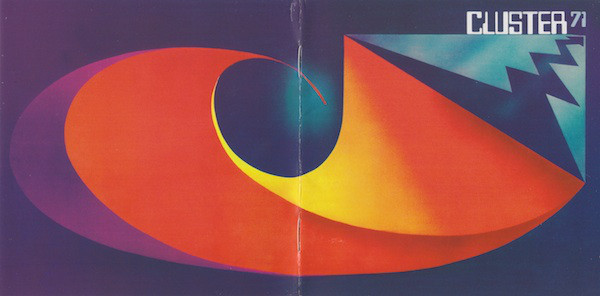
Clustered: The Forgotten Krautrockers Hans-Joachim Roedelius and Dieter Moebius
‘Krautrock’ is now the common nomenclature for German avant-garde of the 70s, although that was not always the case- the term was originally used to mock and dismiss the experimental music bursting out of Germany at the time. The German innovators of Kraftwerk, Can, Faust and Neu! were artists who sought a conscious break from the traditional. These were the vanguards of a brave new revolution in music, a sound that stood in stark contrast to the Led Zeppelin’s at the heart of the Anglo-American music establishment.
Today we will explore one of the more mysterious musical pathways of the Krautrock history: Cluster 71 (1971), perhaps the most misunderstood entree in the German Experimental Music canon. It is a venture into the deepest void of Krautrock. On our way we will meet the two lesser-known musicians at the center of its music, Hans-Joachim Roedelius and Dieter Moebius.
The Zodiac Free Arts Lab
By 1969, the Zodiac Free Arts Lab had become the center of all the experimental, free-jazz and psychedelic activities in the divided city of West-Berlin. It was founded by concept-artist and Joseph Beuys‘ student Conrad Schnitzler and Hans-Joachim Roedelius. A small venue that operated from 1967 through ’69 in the back room of the Schaubühne Theater, it was a refuge for those young people seeking an escape from the safe, bourgeoise society imposed after WWII. And because the Club did not open its doors before very late in the night, the Zodiac kept the number of tourists or poshers to a minimum.
The Zodiac was sub-divided into two musical performance areas, one entirely painted white, the other painted completely black. The club provided amps, instruments and speakers, and audience members were encouraged to use the equipment in the most unconventional ways. The shows were often anarchistic, chaotic and even confrontational- only the most extreme and iconoclastic music was tolerated. The challenging musical performances transformed convention, with sound experiments that often lasted into the daylight hours.
Such extreme music and behavior did not last long, the club was closed by mid 1969. Nevertheless, the facility played an important role in the development of experimental music in Berlin. Significantly, introducing Zodiac owners Conrad Schnitzler (Tangerine Dream) and Hans-Joachim Roedelius to the Club-regular Dieter Moebius. It did not take long for the spark of innovation to ignite, and shortly after their initial meeting, the three formed the first version of Kluster. By July 1969, Kluster was performing 12-hour sets several times per week.
These early performances and the first two Kluster albums were entirely improvisational, and yet they are much more then just improvised jams. Klopfzeichen (1970) and Kluster Zwei Osterei (1971) both employ the hellish sounds of the musical Armageddon the group had developed at the Zodiac. The sound is dense, brutal, chaotic, and helped define the sound that would later be called ‘Industrial’. Each album is filled with meditative and ritualistic chanting, both albums have a unique intensity that can only be called apocalyptic. The music also gives us a hint at the statement soon to be fully realized.
Cluster 71 – The Classic
By 1971 Kluster were transformed. Assuming the new moniker, ‘Cluster’, the duo of Hans-Joachim and Dieter Moebius would shift the industrial driving force of the Kluster albums, and forge a new journey into Kosmische Musik. Creating a soundtrack to the cold and loveless technological society that is blossoming all around us.
Their debut studio album is perhaps the most important jewel in the Krautrock lexicon. Cluster 71 is a turning point and the most misunderstood and underappreciated album in the Krautrock catalogue. Along with producer (and additional band member) Conny Plank, Cluster created the architecture for a new understanding of musical soundscapes. Through the use of sound technology, Cluster was able to create possibly the first sound-portrait of that unnamed sense of lose at the heart of our high-tech world.
Moebius and Roedelius (and Plank) leave behind any effort to create song or structure, working only within the orbit of soundscapes; with a use of technology as musical instrument charting a new language of music and noise. Music is essentially those rules established by human-kind over the course of many centuries, with each generation adding to the meaning. Within that understanding are the mechanisms musicans then use to create “music”. This is how society differentiates between chaotic noise and music. Cluster refine those rules.
The atmosphere on the album is harsh with a modern feeling of detachment and disorientation, it inhabits a surreal and kafkaesk view of the world. On rarest of occasions, a musician, writer or painter will capture more than nostalgia or the Zeitgeist, but the structures of its time. Not a snapshot into a possible future, but a portrait of the world we inhabit. Franz Kafka‘s dystopia in The Trial is the unsettling picture of the remote and bureaucratic landscape we inhabit to this day, the soundtrack created by Moebius and Roedelius an acute reflection of a world of relentless technology and bureaucracy.
Cluster 71 is the definition of deep soulless paranoia. That feeling of restlessness and paranoia is palatable in the creeping uneasiness at the heart of modern life. At the center of the record is a hallow human silence, frightened of the oppressive, bureaucratic world we continue to build. That tension in the music builds upon itself, and individual tracks melt together without individual characteristics. These are not songs in any nostalgic understanding of music or the past, and the album refers to its three tracks without title or identity; 15:33, 7:39 or 21:17.
The German experimental music of the early 1970’s changed the way we view music. With Cluster 71, Moebius & Roedelius scored a soundtrack at the heart of modern man’s failure by creating an album that articulates the dark nature of a technologic and soulless reality. Less then a year later, Tangerine Dream would incorporate many of the same themes on their classic album Zeit, another recommended work that exposes the kafkaesk reality we endeavor to build upon with each new iPhone and Alexia we acquiesce to.
By 1974, Cluster had toured extensively throughout Europe. Roedelius and Moebius finding relief from the intensity of life on the road by joining an international community of musicians in a studio in Forst, a small town deep in the countryside of Lower Saxony in Germany. The album they recorded there, Zuckerzeit (1974), was a major shift away from the paranoid soundscapes of the past. Micheal Rother was credited as the albums co-producer, who at the time was also recording NEU! ’75 (1975) in Cologne.
That new partnership spowned at more melodic sweetness than there had been in the past. Rother, Roedelius and Moebius formed Harmonia in 1976 and worked on the next Cluster album Sowiesoso (1976), with Rother as a full member of the band. As fluid melodic albums, both Sowiesoso and Musik Von Harmonia (1974) demonstrate the significance of Michael Rother’s influence on the sound of Cluster, with the new, melodic influence eventually leading to a collaboration with another artist traveling in their Forst-orbit: Brian Eno.
We were fortunate enough to have an interview with Michael Rother (read here), where he answers our questions about Cluster and Harmonia, and reveals a never heard truth about his ‘sabotaged’ collaboration with David Bowie. A special thanks goes to Russ Curry, President and Founder of Curious Music. Russ has worked extensively with the members of that particular German scene and is currently helping Hans-Joachim Roedelius with a patron pag: patreon.com/roedelius . You can also pre-order the upcoming Roedelius biography exclusively on his label’s website curiousmusic.us
by Shawn Ciavattone

[…] Cluster track ‘Im Süden‘ appealed to me because it had a similar melodic approach as the one I […]
Shawn,
I thought that I remembered commenting on this Cluster piece you wrote when you first published it but perhaps I commented on your other Cluster article rather than this piece.
You have completely captured what makes Cluster ’71 such a standout, stark, and strange record–as you have described in descriptive details, Cluster ’71 is “a soundtrack to the cold and loveless technological society”, “harsh with a modern feeling of detachment and disorientation, it inhabits a Kafkaesque view of the world”, “world of relentless technology and bureaucracy”, “deep soulless paranoia”, “hollow human silence frightened of the oppressive, bureaucratic world we continue to build”.
Where Cluster’s earlier records sound either more industrial, the complex chaos of the city (Cluster ’71) or celebrating the urbane pleasures of the city (Zuckerzeit), I have always preferred their ambient pastoral soundscapes in Sowiesoso–still my favorite Cluster record.
[…] else is going to satisfy my mood or hold my attention. I’ll need a full week or two of Cluster or whatever my current obsession is. And this goes for more than just my musical habits. […]
Good post. We are linking to this particularly great article on our site. Keep up the good writing.
Great article. Very informative! Carmen ….
One of the most extraordinary electronic records ever released. No one else but Conrad Plank could have helped realize probably the most radical work of Moebius and Roedelius. Nothing but sounds that trigger different emotions, that radiate warmth and are full of surprises. Cluster ’71 of the records that most radically defined the term Krautrock in a musically extreme manner. Fantastic read along with the interview, love the page!
Thank you so much for the kind feedback. It’s great to be able to discuss some of the amazing music from the German Experimental scene outside the usual bands; Kraftwerk, Can…
Great job Shawn, so glad that you do justice to Cluster, they are the forgotten “krautrockers”. There was a period in which I was obsessed with Neu! and CAN. When I got into Cluster, my mind continued the expansion process, a truly unique sound and complex experimentation techniques.
Thank you Octavio. That exploration into Krautrock is absolutely essential to anyone truly interested in music. One of the few journeys into the past were you can hear the sounds of today and tomorrow.
Fantastic feature, as you say this record is immensely overlooked. Boiling noises, melody-free chirpings, ash-gray industrial aesthetics, flickering telegraph-poles, juicy dissonance and improvisation- a dream-free, word-free, but also psych-free record. Still a terrifyingly “evil” record today, and pretty much the opposite of what ‘Krautrock’ usually stands for.
Not being a big fan of the late Cluster (Zuckerzeit etc.) this one really surprised me and grew into a favorite. Mindblowing soundscapes and pioneering work. I’m glad I listened to you on this one (not on Yorke) . But oh the birth of this article… it turned out great, just like the interview. I’ll take some credit for the inspiration, ok? 😘Till later
Incredible that Cluster ’71 is almost 50 years old! Psychedelic soundscapes with no compromises, simply creating space & atmosphere that inspires the mind. Great article, great work of pre-electronic german music!
Cluster 71 is an album like no other. It so often gets overlooked. Hopefully we are able to shine a bit of light on the music. Thank you for the comments.